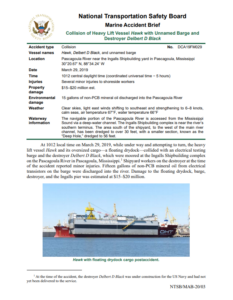While underway in March 2019, the heavy lift vessel Hawk collided with a barge and a destroyer on Mississippi river. The NTSB issued an investigation report on the collision, identifying exceeding speed as key cause of the accident.
The incident
At 1012 local time on March 29, 2019, while under way and attempting to turn, the heavy lift vessel Hawk and its oversized cargo—a floating drydock—collided with an electrical testing barge and the destroyer Delbert D Black, which were moored at the Ingalls Shipbuilding complex on the Pascagoula River in Pascagoula, Mississippi.
Shipyard workers on the destroyer at the time of the accident reported minor injuries.
Fifteen gallons of non-PCB mineral oil from electrical transistors on the barge were discharged into the river.
Damage to the floating drydock, barge, destroyer, and the Ingalls pier was estimated at $15–$20 million.
Probable cause
The National Transportation Safety Board determines that the probable cause of the collision of the heavy lift vessel Hawk with a docked barge and the destroyer Delbert D Black was the speed at which the conning pilot was operating the Hawk while attempting to turn and anchor in a shipyard basin.
Analysis
As the Hawk approached the end of the channel prior to the turn into the Ingalls shipyard basin, the southeast wind (which had increased to 6–8 knots) was on the vessel’s stern.
As the vessel commenced the turn towards the Deep Hole, the wind that was previously on the vessel’s stern was on its port quarter and port side, pushing the vessel towards the dock and the destroyer.
Considering the large sail area presented by the drydock, the NTSB conducted a study to estimate the impact of the wind on the turning ability of the Hawk during the maneuver into the Deep Hole (M/V Hawk Wind Effect Study).
The study found that the 8-knot wind had only a small effect. Thus, the increased wind was likely not a significant factor in the accident.
Although the tidal current was near maximum flood at the time of the accident, the range of tide was small (1.44 feet), and the period was long (nearly 12 hours). The effect of the flood current was likely minimal.
A captain of a fishing vessel located in the Pascagoula River related to the pilots that he was experiencing no current.
As the Hawk approached the entrance to the Pascagoula River, the master warned the pilots that the vessel was slow in reducing speed and recommended reducing speed earlier.
However, pilot 1 was reluctant to reduce the vessel’s engine speed over concerns that he would have less rudder control and that the vessel would be set down onto the port side of the channel.
The pilot instead opted to use the tugboats made up to the stern to slow the Hawk, eventually ordering back full on both tugboats.
Pilot 2 told investigators that “we knew we had a speed problem before the turn” toward the Deep Hole.
The vessel did not slow as pilot 1 expected, and the tugboats made up to the stern did not have enough power to sufficiently reduce the Hawk’s speed prior to making the turn.
Explore more herebelow:





























































